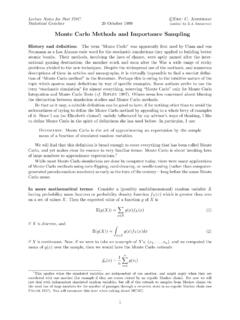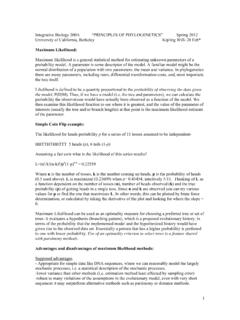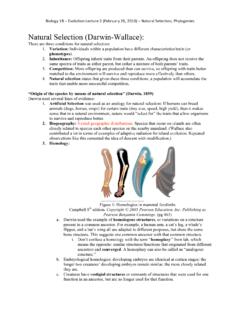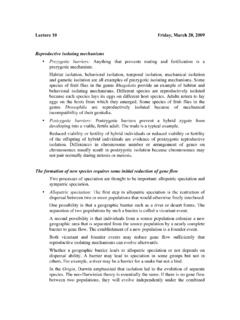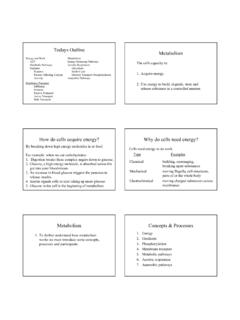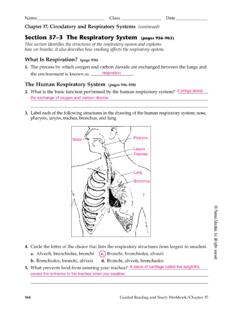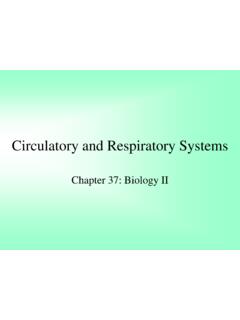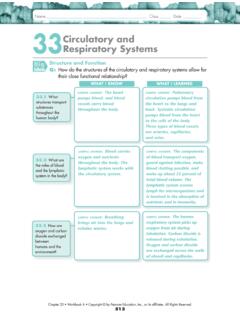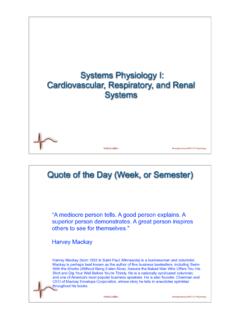Transcription of Circulatory System - Integrative Biology
1 Circulatory System1. Function2. Components Heart Blood Vessels (vein & arteries) Lungs Lymphatic systemFunctional Connectionsfood, water intakeoxygen intakeDIGESTIVESYSTEMRESPIRATORYSYSTEM eliminationof carbondioxidenutrients,water,saltsoxygen carbondioxideURINARYSYSTEM water,soluteseliminationof foodresiduesrapid transportto and from allliving cellselimination ofexcess water,salts, wastesFigure from page 559 of your textCIRCULATORYSYSTEMC irculatory System1. Accepts oxygen, nutrients, and other substances from the respiratory and digestive systems and delivers them to cells2. Accepts carbon dioxide and wastes from cells and delivers them to respiratory and urinary systems for disposal3.
2 Also functions in temperature and pH of the Circulatory System Fluid blood, hemolymph, coelomic fluid Tubes arteries go away from heart;veins return to heart Pump heart or pulsating vesselCirculatory Systems in Various PhylaNo Circulatory SystemPoriferaCnidariaPlaythelminthesNem atodaOpen Circulatory SystemArthropodaMollusca (except squid and octopuses)EchinodermataChordata (tunicates)Closed Circulatory SystemAnnelidaMollusca (squid and octopuses)Chordata (cephalochordates and vertebrates) Circulatory SystemsAnnelidaOpen systemArthropodaAnnelidaClosed systemAnnelidaClosed Circulatory System Heart pumps blood in large arteries away from your heart.
3 Diffusion occurs in tiny capillaries. Blood returns to heart in large veins. Large vessels for bulk transport fast flow (2-4 cm/sec) large diameter (10-12 mm diameter) thick walls (muscular) Capillaries for diffusion Slow flow (<1 mm/sec) Small diameter ( mm) Very thin walls (single cell layer) Fit one RBC through at a time. RBCs scrape a pump (heart), arteries, veins, capillariesOxygen-rich bloodOxygen-poor bloodCapillariesArteriesVeinsCapillaries Blood Volume and CompositionBlood is alive! Blood is 90% Plasma portion 50-60 percent of volume Water, plasma proteins, dissolved ions and molecules2. Cellular portion 40-50 percent of volume Red cells, white cells, and plateletsErythrocytes1.
4 Red blood cells transport oxygen from lungs to aerobically respiring cells and carry carbon dioxide wastes from Red blood cells have no nucleus (no DNA). They are created in bone marrow with enough proteins to last about 120 Phagocytes engulf old (White Blood Cells)1. Cleaners and defender engulf damaged and dead cells and anything tagged as Some signal the immune System to mount a Elevated levels of white blood cells indicate to physicians that there is an infection. Megakaryocytes(Platelets)1. There are hundred of thousands of platelets circulating in They live for about 8 They respond to injury by releasing chemicals that initiate blood clottingRed Blood Cells in a ClotMacrophages, Lymphocytes, and Red Blood CellsSickle Cell AnemiaBlood Vessels1.
5 Arteries: main transporters of oxygenated blood2. Arterioles: diameter is adjusted to regulate blood flow3. Capillaries: diffusion occurs across thin wallsFigure from page 562 of your textThe Venous System1. Blood flows from capillaries into venules, then on to veins2. Veins are large-diameter vessels with some smooth muscle in wall3. Valves in some veins prevent blood from flowing backwardFigure from page 562 of your textVenous Pressure1. Veins Large diameter Low resistance Valves One-way flow Blood Reservoir 50-60% or total blood volumeFigure page 565 of your textVessel Sizes and Flow RatesDiameter Cross-sectional VelocityVessel (mm) NumberArea (cm2) (cm/sec)Aorta Arteries 10-300 Billion 600< Veins 64020 Vena 5-20 Flow Analogyriver inriver outlake123 123123 Vertebrate Hearts and Circulation2-chambered heartFishes3-chambered heartAmphibians, Reptiles4-chambered heartBirds, Crocodiles,MammalsVertebrate Systems1.
6 Fish Two-chamber heart pumps blood through one circuit2. Amphibians Heart pumps blood through two partially separate circuits3. Birds and mammals Four-chamber heart pumps blood through two entirely separate circuitsThe HeartRIGHTLEFTThe HeartVena CavaDelivers oxygen-poor blood to heartThe HeartAortaDelivers oxygen-rich blood to bodyAortaThe HeartPulmonary ArteryDelivers oxygen-poor blood to lungsThe HeartRight atriumRight ventricleLeft atriumLeft ventricleThe HeartRight atriumRight ventricleLeft atriumLeft ventricleThe HeartRight atriumRight ventricleLeft atriumLeft ventricleThe HeartRight atriumRight ventricleLeft atriumLeft ventricleHuman Heart in ChestRight AtriumRight VentricleLeft AtriumLeft VentricleHuman HeartRight AtriumLeft VentricleRight VentricleLeft AtriumRight
7 AtriumRightVentricleConduction and Contraction1. SA node in right atrium is pacemaker2. Electrical signals cause contraction of atria3. Signal flows to AV node and down septum to ventriclesSA nodeFigure (b) from page 561 of your textAV nodeHeart Contraction AnimationSuperior vena cavaInferior vena cavaOxygen-poor blood from head and upper limbsOxygen-poor blood from lower trunk and legsPulmonary veinsOxygen-richBlood to heartPulmonary arteryOxygen-poorBlood to lungsAorta (artery)Oxygen-richBlood to bodyHeart Contraction AnimationPulmonary CircuitShort loopthatoxygenatesbloodright pulmonary arteryleft pulmonary arterycapillarybed ofrightlungpulmonarytrunkcapillarybed ofleft lung(to systemic circuit)pulmonary veinslungs(fromsystemiccircuit)heartFigu re (b)
8 From page 559 of your textRightAtriumCirculation AnimationSystemic CircuitLonger loop that carries blood to and from body tissuescapillary beds of headand upper extremities(to pulmonarycircuit)aorta(frompulmonarycirc uit)heartcapillary beds of otherorgans in thoracic cavitycapillary bed of livercapillary bedsof intestinesFigure (a)from page 559 of your textcapillary beds lower extremitiesCirculation AnimationDirection of Blood Flow1. Superior and inferior vena cava 2. Right atrium3. Right ventricle4. Pulmonary artery 5. Pulmonary veins6. Left atrium7. Left ventricle8. AortaLUBLUBDUBDUB1stPump2ndPumpCardiac CycleBlood Pressure1. Contraction phase is systole when ventricles are fully Relaxation phase is diastole when ventricles are diastoleVentricularsystole Figure from page 561 of your textArteriole Blood Pressure1.
9 Resting blood pressure measures maximum systolic pressure and diastolic blood pressure (most relaxed ventrical state).2. An average measure of 120/80 mm Hg is systolic pressure over diastolic pressure in millimeters of mercury (how far the pressure pushes Hg in a glass Blood PressureBlood pressure is measured using an inflatable cuff wrapped around the biceps. The cuff is attached to a pressure gauge. A stethoscope is placed over the brachial DopingAthletes withdraw and save blood just before an event. Withdrawal triggers manufacture of new RBCs. Athlete then adds original blood back into body. Extra RBCs increase O2carrying and AtherosclerosisArteriosclerosis hardening of the arteries arteriesthicken and lose elasticityAtherosclerosis deposition of fatty substancesinside artery walls and narrow the cause high blood pressure, chest pain, heart attack, stroke, or Cholesterol is used to make cell membranes, myelin sheaths, bile salts, and steroid The liver makes enough cholesterol for all of these, but we ingest extra cholesterol and the body has to deal with Most cholesterol in the blood is bound to proteins as low-density lipoproteins (LDLs).)
10 A small amount is bound to high-density lipoproteins (HDLs). 4. HDL is taken up and metabolized by the liver. 5. Over time LDL deposits cholesterol on artery walls and can lead to SystemHuman heart with coronary arteries in redAtherosclerosis in Arteriesnormalnormalocclusionplaque buildupatherosclerotic plaqueblood clotnarrowedlumenpartialocclusionnearlyo ccluded10 Leading Causes of Death, United States, 1999 - 2001, All Races, Both Sexes0500,0001,000,0001,500,0002,000,000 2,500,000 Cause of DeathHeart Disease - 37%Cancer - 29%Stroke - 9%Other - 25%No. of DeathsARisk Factors for Cardiovascular Disease Smoking Genetic factors High cholesterol Obesity Lack of exercise Diabetes mellitus Gender (maleness) Old ageNew Heart Bypass Surgery Method Video ClipLymphatic System1.
